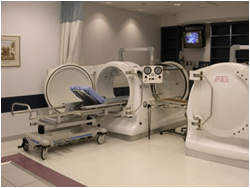Hyperbaric Wound Care
A Multidisciplinary Approach to Better Wound Care
A wound that won’t heal may need more than just conventional wound care – it needs the Hyperbaric Wound Care Center at West Jefferson Medical Center to provide a comprehensive treatment designed to complement the primary physician's care.
More than 3.5 million Americans suffer from wounds that may not heal after months, or even years, of traditional treatment. Chronic wounds are often painful and upsetting – and when associated with diabetes or poor circulation, they can be very difficult to heal. Whatever the cause, it’s important to diagnose and treat the problem correctly. That’s why the physicians and other specialists at our Hyperbaric Wound Care Center are here for you. A specially trained team of physicians, nurses, and technologists provide comprehensive, cost-effective wound care to patients with non-healing wounds.
A chronic or non-healing wound is defined as a wound that has not significantly improved during the course of conventional treatment. Hyperbaric oxygen therapy is often the best way to treat a chronic wound.
Hyperbaric oxygen therapy
Hyperbaric oxygen therapy (HBOT) allows a person to breathe 100% oxygen while they are in a pressurized chamber. The pressure forces oxygen into the blood plasma, which is then better able to deliver oxygen to wounds that are low in oxygen. Low oxygen levels in a wound cause it to heal slowly or not at all.
Hyperbaric oxygen therapy can lend a number of clinically observed benefits to wound healing, such as:
- Enhanced ability of white blood cells to kill bacteria
- Reduction of ischemia-reperfusion injury
- Reduction of pathologic inflammation
- Reduction of edema
- Increased neovascularization
- Increased granulation tissue
- Increased epithelization
- Increased osteogenesis
The HBOT process
HBOT is administered to a patient resting inside a pressure vessel, known as the monoplace (single occupancy) chamber. The monoplace chamber (WJMC has two) is made of a seamless acrylic material. These chambers are pressurized with 100% oxygen instead of air. Patients lie on stretchers and are able to watch television (looking through the acrylic walls) or take a nap.
How to receive hyperbaric oxygen treatment
HBOT is usually offered as a referral and consultation service. A consultation appointment will be made for the patient once the written referral and authorization has been received by the referring physician.
The patient’s first appointment will last several hours. The appointment will consist of an in-depth assessment by our hyperbaric wound care team; a review of the patient’s medical history; and blood tests or additional tests if needed. These assessments will determine if the patient has an accepted indication for treatment.
Indications for treatment approved by the CMS include:
- Air or gas embolism
- Carbon monoxide poisoning and smoke inhalation
- Clostridial myositis and myonecrosis (gas gangrene)
- Crush injury, compartment syndrome, and acute traumatic ischemia
- Decompression sickness
- Arterial insufficiencies such as central retinal artery occlusion, selected problem wounds
- Severe anemia
- Intracranial abscess
- Necrotizing soft tissue infections
- Osteomyelitis (refractory)
- Delayed radiation injury (soft tissue and bony necrosis)
- Compromised grafts and flaps
- Acute thermal burn injury
- Idiopathic sudden sensorineural hearing loss
Once the accepted indication is determined, the treatment plan is communicated to the primary care physician, who remains an active member of the patient’s wound care management.
HBOT is a supplemental therapy to be used in addition to current medical and surgical therapy. The Hyperbaric Wound Care Center provides outpatient and inpatient wound care on an individualized care plan designed to provide the patient with the best possible healing outcomes.
Contact the Hyperbaric Wound Care Center at 504.349.6558.


